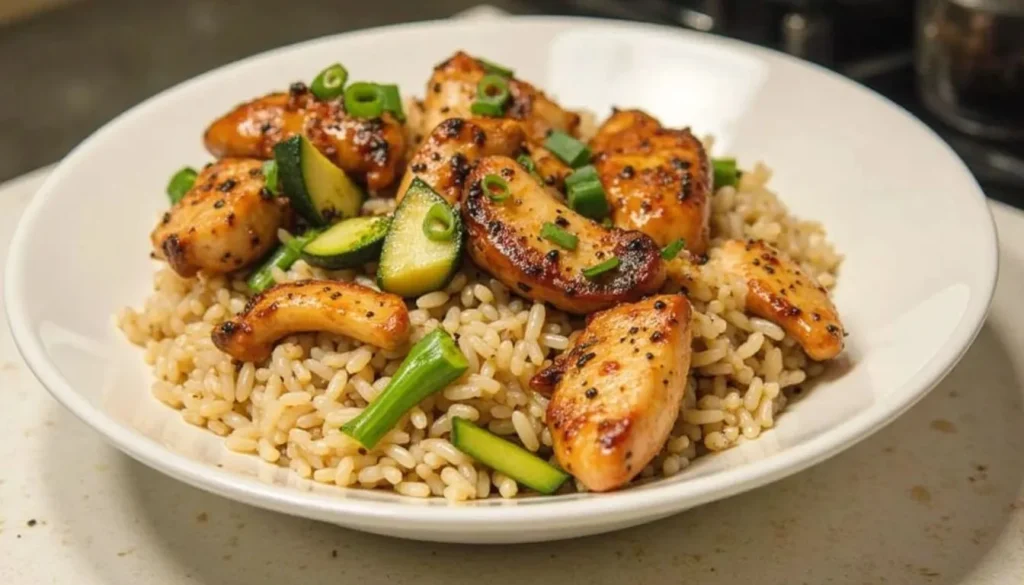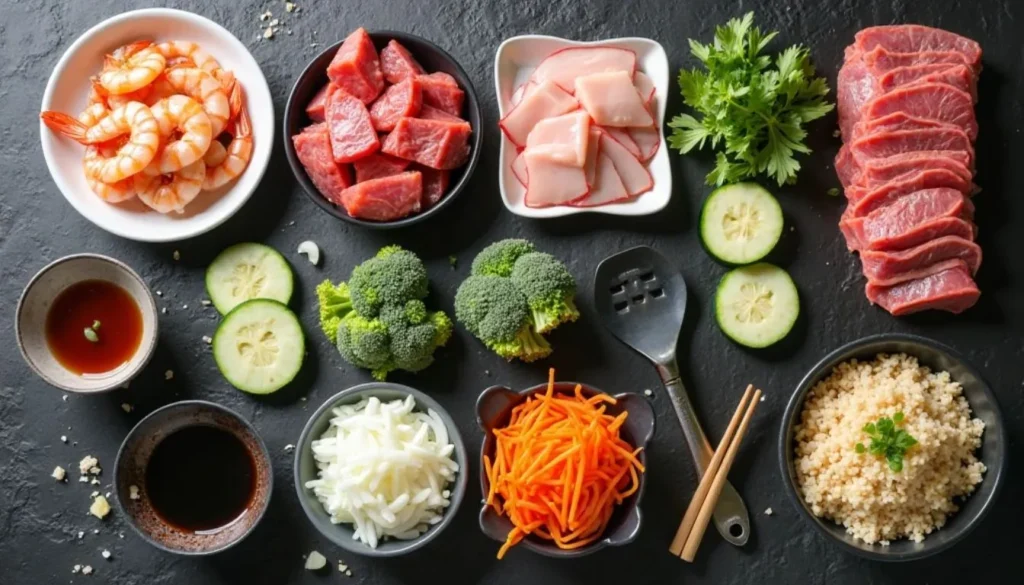The sizzle of the grill and the rhythmic chopping of ingredients are unforgettable. These moments from my favorite Japanese restaurant inspired me to try hibachi cooking at home. Hibachi cooking is more than just a meal; it’s an experience that turns simple ingredients into amazing dishes.
Ever watched a hibachi chef cook with flair and thought, “I wish I could do that at home”? You can! This guide will show you how to make restaurant-quality meals in your kitchen. It brings the excitement and flavors of hibachi cooking right to your table.
With a few simple techniques and the right ingredients, you can master hibachi cooking. Whether you love cooking or are just curious, this guide will teach you. You’ll learn to make delicious hibachi-style meals that will wow your family and friends.
Table of Contents
Understanding Hibachi-Style Cooking at Home
Hibachi cooking has changed from a traditional Japanese heating device to a fun cooking experience. It brings restaurant-style excitement to your kitchen. When you make homemade hibachi steak, you’re not just cooking. You’re creating an interactive dining adventure at home.

What is Hibachi Cooking?
Traditionally, hibachi was a portable heating device in Japan. In Western cuisine, it has evolved into a dynamic cooking style. It involves high-heat grilling and theatrical food preparation. When you try hibachi at home, you’ll find a cooking method that’s fast, flavorful, and entertaining.
Traditional vs. Modern Hibachi Methods
The modern version of hibachi is very different from its traditional roots. Today, hibachi focuses on:
- High-temperature cooking on a flat griddle
- Quick searing of proteins like steak and chicken
- Dramatic cooking techniques
- Simultaneous preparation of proteins and vegetables
Essential Equipment for Home Hibachi
You don’t need special equipment to have a real hibachi experience. You can get great results with:
- Large flat griddle or cast-iron skillet
- High-heat cooking oil
- Sharp chef’s knife
- Spatulas and tongs
Mastering homemade hibachi steak is about technique, heat control, and fresh ingredients. With practice, you’ll turn your home kitchen into a sizzling hibachi restaurant.
Benefits of Making Hibachi Recipe at Home
Preparing a hibachi recipe at home has many benefits. It’s not just about enjoying a tasty meal. It opens up a world of creativity and satisfaction in your kitchen.
One big advantage is saving money. Hibachi meals at restaurants can cost $25-$50 per person. But making your own hibachi recipe lets you enjoy great flavors for much less.
- Save money on dining out
- Control ingredient quality
- Customize flavors to your preference
- Create healthier meal options
Health-conscious cooks love the control they have at home. You can pick the best ingredients and control how much you eat. This way, you can make hibachi meals that are healthier and tailored to your taste.
- Choose organic proteins
- Reduce sodium content
- Limit added oils
- Incorporate more vegetables
| Aspect | Restaurant Hibachi | Home Hibachi |
|---|---|---|
| Cost per Serving | $25-$50 | $8-$15 |
| Ingredient Control | Limited | Complete |
| Customization | Minimal | Unlimited |
Another great thing about hibachi at home is the fun it brings. It turns cooking into a family activity. You can teach others how to cook and make special memories together in your kitchen.
Essential Ingredients for Authentic Hibachi Dishes
To make tasty homemade hibachi dishes, you need the right ingredients. These ingredients bring the true taste of Japanese cooking to your table. Start your cooking adventure by learning about the key ingredients that make hibachi meals so delicious.

Protein Options for Hibachi Cooking
Choosing the right protein is key for homemade hibachi steak, chicken, or shrimp. Each protein adds its own special texture and taste to your dish:
- Homemade hibachi steak: Choose ribeye or sirloin cuts for tender results
- Hibachi chicken: Use boneless, skinless chicken thighs for maximum flavor
- Hibachi shrimp: Select large, fresh shrimp for the best taste and texture
Vegetables and Aromatics
Fresh vegetables make your hibachi meal amazing. The right mix adds color, nutrition, and flavor:
| Vegetable | Flavor Profile | Preparation |
|---|---|---|
| Zucchini | Mild, slightly sweet | Sliced diagonally |
| Onions | Sharp, caramelizes beautifully | Thick ring cuts |
| Mushrooms | Earthy, umami | Quartered or sliced |
Sauces and Seasonings
The secret to real hibachi flavor is in its seasonings. Make magic with these essential ingredients:
- Soy sauce: Base of most hibachi marinades
- Garlic and ginger: Fresh, minced for intense flavor
- Sesame oil: Adds nutty undertone
- Teriyaki sauce: Sweet and savory finishing touch
Mastering these ingredients will turn your home cooking into a hibachi restaurant-quality meal. It will impress everyone every time.
Mastering Basic Hibachi Techniques
Starting with japanese grill cooking means learning the basics. Hibachi at home is special because of its high-heat cooking and precise methods. These skills turn simple ingredients into dishes that taste like they’re from a restaurant.
Key techniques for successful hibachi cooking include:
- High-Heat Searing: Use a flat griddle or cast-iron skillet to achieve intense heat
- Quick Cooking: Prepare ingredients in advance for rapid cooking
- Season ingredients right before cooking for maximum flavor
- Keep ingredients moving to prevent burning
When cooking hibachi at home, your cooking surface is key. A flat, heavy-bottomed pan works like a traditional hibachi grill. Preheat it well to get a perfect sear on meats and veggies. You want a crispy outside and a juicy inside.
Timing is important in japanese grill cooking. You should:
- Cut ingredients into uniform sizes
- Organize ingredients within easy reach
- Cook proteins first
- Cook vegetables quickly at high heat
Mastering these techniques takes practice. Start with simple recipes and build your skills over time. With patience, you’ll make delicious hibachi meals that are just as good as those in restaurants.
Preparing the Perfect Hibachi Chicken
Creating an authentic hibachi chicken recipe at home can turn your kitchen into a delicious culinary experience. Mastering the art of hibachi-style cooking requires attention to detail and understanding key techniques. These techniques bring out the most incredible flavors.
The secret to exceptional hibachi chicken lies in three key elements: marinading, seasoning, and high-heat cooking. Your goal is to replicate the vibrant flavors and restaurant-quality results that make hibachi chicken so irresistible.
Chicken Marinade Instructions
A perfect hibachi chicken marinade combines several key ingredients to enhance flavor and tenderness:
- Soy sauce for depth and umami
- Fresh minced garlic for aromatic intensity
- Grated ginger for a subtle kick
- Sesame oil for rich undertones
Cooking Temperature and Timing
Achieving the ideal hibachi chicken requires precise cooking techniques. Use a flat griddle or large skillet with high heat to create that signature sear.
| Cooking Stage | Temperature | Cooking Time |
|---|---|---|
| Initial Sear | 425-450°F | 2-3 minutes per side |
| Final Cooking | 375-400°F | 3-4 minutes |
Achieving Restaurant-Style Results
To elevate your hibachi chicken, focus on technique and timing. Cut chicken into uniform pieces, ensure your cooking surface is extremely hot, and avoid overcrowding the pan. Keep the chicken moving to prevent burning while creating a beautiful golden-brown exterior.
With practice, you’ll master the art of making restaurant-quality hibachi chicken right in your own kitchen. Impress family and friends with your culinary skills.
Creating Signature Hibachi Sauces
Make your hibachi recipe shine with homemade sauces. These sauces turn simple meals into unforgettable dishes. Teppanyaki sauce is the key to bringing restaurant flavors home.
Mastering these sauces is key to your hibachi cooking journey. Each one adds a special flavor that boosts your dishes:
- Yum Yum Sauce: A creamy, tangy condiment perfect for seafood and chicken
- Ginger Sauce: A zesty, refreshing accompaniment that cuts through rich proteins
- Teriyaki Sauce: Sweet and savory, ideal for beef and vegetable dishes
When making your teppanyaki sauce, aim for the right balance of flavors. Begin with mayonnaise, tomato paste, butter, garlic powder, and paprika for a basic yum yum sauce. Adjust the amounts to suit your taste.
Pro tip: Using fresh ingredients is vital. Making sauces from scratch lets you control sodium and flavor.
Proper storage is key to keeping your sauces fresh. Store them in airtight containers in the fridge. Use them within 5-7 days for the best taste and safety.
Hibachi Vegetables: The Perfect Side Dish
Japanese grill cooking turns simple veggies into amazing dishes. Picking the right veggies and learning how to cut them is key. This can make your cooking as good as a restaurant’s.
It’s important to choose the right veggies for hibachi cooking. Not all veggies do well under high heat. Knowing which ones are best can really improve your dish.
Vegetable Selection Guide
When picking veggies for hibachi, look for ones that keep their texture and taste when grilled. Here are some top picks:
- Zucchini: Keeps its shape well and soaks up flavors fast
- Bell peppers: Add bright color and sweet taste
- Onions: Get sweet and caramelized when heated high
- Mushrooms: Give a meaty texture
- Carrots: Are crunchy and sweet
Proper Cutting Techniques
Cutting veggies right is key for even cooking and a nice look. Try to cut them so they cook the same.
| Vegetable | Recommended Cut | Size (inches) |
|---|---|---|
| Zucchini | Diagonal slices | 1/2 inch thick |
| Bell Peppers | Strips | 1/4 inch wide |
| Onions | Wedges | 1 inch thick |
| Mushrooms | Halved or quartered | 1/2 inch pieces |
Pro tip: Always cut veggies just before cooking to keep them fresh and prevent them from turning brown. Paying attention to detail will make your hibachi veggies stand out.
Perfecting Hibachi Fried Rice
Making hibachi fried rice at home is simpler than you might think. This tasty side dish brings Japanese-style cooking to your kitchen. The secret to a great hibachi recipe is choosing the right ingredients and mastering a few techniques.
Begin with day-old rice for the best texture. Fresh rice is too moist and can make your dish soggy. Opt for medium-grain Japanese-style white rice for the perfect sticky consistency.
- Use cold rice from the refrigerator
- Select high-heat cooking oil like vegetable or peanut oil
- Prepare ingredients before cooking
- Cook on high heat for authentic flavor
Your hibachi fried rice needs a few key ingredients for that restaurant taste:
- Butter for rich flavor
- Soy sauce for umami depth
- Fresh eggs
- Chopped vegetables like onions and carrots
The cooking method is critical for hibachi fried rice. Use a large skillet or wok and keep ingredients moving. Aim for slightly crispy rice with flavors evenly spread, just like professional chefs.
Tips for Achieving Restaurant-Quality Results
Mastering hibachi at home needs precision and skill. Japanese grill cooking is an art that requires attention to detail and practice. To create an authentic hibachi experience, you must understand the techniques used by professional chefs.
To turn your home kitchen into a hibachi grill station, focus on several key factors. These can take your cooking from amateur to professional-level.
Mastering Temperature Control
Successful hibachi at home starts with heat management. Your cooking surface needs consistent high heat for those signature seared flavors:
- Preheat your cooking surface for at least 5-7 minutes
- Use a cast-iron griddle or flat-top grill for best results
- Maintain temperatures between 400-450°F for optimal Japanese grill cooking
Precision Timing and Coordination
Timing is everything in hibachi cooking. Professional chefs make it look effortless, but it takes practice to coordinate multiple ingredients:
- Prepare all ingredients before starting to cook
- Cook proteins first, then vegetables
- Keep ingredients moving to prevent burning
- Use high heat and quick cooking techniques
With patience and practice, you’ll soon create restaurant-quality hibachi meals right in your own kitchen.
Common Mistakes to Avoid When Making Hibachi
Learning to make hibachi at home can be tough. Many people struggle to get it right, missing out on the taste of a restaurant. Knowing what mistakes to avoid can help you improve your cooking.
Choosing the right cooking surface is key. Don’t overcrowd it. If you do, your food will steam instead of sear. This means it won’t have the crispy texture that makes hibachi so tasty.
- Heat management is critical for great hibachi
- Low heat stops proper caramelization
- Not enough seasoning means less flavor
Getting the temperature right is important. Your hibachi needs high, steady heat for those charred edges and deep flavors. Use cast-iron or heavy steel griddles for even heat.
The oil you choose is also important. Avoid olive oil because it burns easily. Instead, use oils like vegetable, canola, or peanut oil. They stay stable at high temperatures, adding to the authentic taste of hibachi.
- Choose oils with high smoke points
- Make sure your surface is hot before cooking
- Cut ingredients the same size for even cooking
With practice and patience, you can make amazing hibachi at home. Focus on timing, preparing your ingredients well, and managing the heat. This way, you can create meals that rival those from restaurants.
Meal Prep and Storage Guidelines
Preparing a delicious hibachi recipe at home is easy. Smart meal prep saves time and ensures a great dinner. With proper storage, your ingredients stay fresh and tasty for days.
Here are key meal prep strategies for hibachi at home:
- Marinate proteins up to 24 hours in advance
- Chop vegetables the day before cooking
- Prepare sauces and store in sealed containers
- Pre-measure seasonings in small containers
Storage is key to keeping your hibachi ingredients fresh. Refrigeration helps preserve taste and texture. Here are some storage tips:
- Marinated meats: Store in airtight containers for 1-2 days
- Chopped vegetables: Keep in sealed containers for up to 3 days
- Cooked hibachi dishes: Refrigerate and consume within 3-4 days
- Sauces: Typically last 5-7 days when refrigerated
Reheating hibachi meals needs care to keep the flavor. Use a skillet or wok on medium heat, adding a bit of oil to prevent sticking. Stir often to heat evenly and avoid overcooking.
By following these tips, you can enjoy top-notch hibachi recipes at home with little daily prep.
Conclusion
Learning to make a hibachi recipe at home is easier than you might think. With a bit of practice and the right techniques, you can turn your kitchen into a personal hibachi restaurant. You’ll be able to make meals that wow your family and friends.
Your journey to cooking hibachi at home is about trying new flavors and ingredients. It’s about growing your cooking confidence. Every dish you make will help you get better, from searing proteins to cooking veggies and rice just right.
Cooking is like an art, and hibachi cuisine is full of creative possibilities. Start with simple recipes and then try more complex ones. Your kitchen becomes a place where you can try new things and mix traditional methods with your own ideas.
Enjoy the learning process and every tasty moment of cooking hibachi. Your skills will keep growing, making hibachi-style meals a part of your home cooking.
Tried Our Recipe Yet?
There are no reviews yet. Be the first one to write one.

